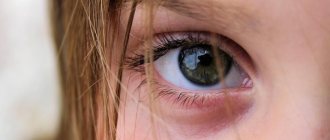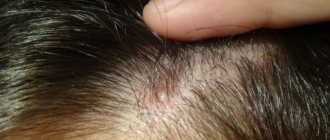Causes of bruises under the eyes in infants?
Need to know! The causes of bruises under the eyes in infants can occur for the following pathological reasons:
- Development of anemia . This disease is characterized by a lack of hemoglobin in the blood, which can be easily corrected by including foods and supplements containing iron in the diet. The disease manifests itself primarily by the appearance of bruises that have a pale pink tint.
- Vegetovascular dystonia . In such cases, bruises are accompanied by swelling, and other symptoms are also observed. Among them are heart rhythm disturbances, cold extremities in any weather, behavioral disorders (the child becomes anxious and capricious).
- Weakened immunity due to viral diseases . With proper treatment and compliance with preventive measures, bruises under the eyes are temporary and disappear within a few days.
- Pathologies of the endocrine system . Basically, bruises in such cases occur due to dysfunction of the thyroid gland. The sooner such a disease is detected, the more successful the treatment will be and the less likely it will be to develop complications.
- Liver and kidney diseases . This is the most serious cause of bruises under the eyes, which are the primary symptom of such disorders in infants. With such a pathology, a full comprehensive examination and timely treatment are required.
For your information! Sometimes hematomas under the eyes occur not as a result of diseases of the internal organs, but as a result of disorders provoked by external factors:
- Increased eye fatigue , characteristic of the visual organs of infants who are not yet accustomed to such stress.
- Lack of proper sleep . This can easily be explained by the fact that in the first weeks and months of life, children's sleep is unstable. Babies often wake up at night and fall asleep for several hours; moreover, awakenings are constantly accompanied by crying, which makes their eyes swollen and the likelihood of bruising increases.
- Hereditary disorder . In these cases, you just have to accept the presence of bruises and hope that over time the symptom will become less noticeable.
- Hematomas can appear due to the fact that the skin under the child’s eyes is very thin and under it there is normally no fat layer that covers the capillaries. Therefore, vessels can appear through the skin, creating the appearance of bruises .
Important! The cause of such a violation can also be banal injuries: when tissues and capillaries are damaged, hemorrhage occurs.
As a result of such processes, blue bruises appear, which during the healing process become greenish and then yellow, after which they disappear.
Causes
There are cases when bruises under the eyes of a baby can be a physiological phenomenon. In other cases, this is a manifestation of exposure to negative factors. Therefore, when they are eliminated, the symptom gradually disappears.
Heredity
If the parents of a child have pronounced bruises under the eyes, which are formed not due to illness, but due to thin skin and a certain localization of blood vessels, this manifestation often occurs in the offspring. It is useless to treat the symptom; it cannot be eliminated with the help of medications and folk remedies. The sign does not affect the baby's health.
Mode
After birth, the child does not have any routine. He falls asleep and wakes up only when he is tired or hungry. Gradually, parents should accustom the child to a certain routine and regime, so that he gets up in the morning, has several daytime sleeps, and goes to bed before 10 pm. Only in this case are normal biorhythms formed in the baby’s life.
Otherwise, the child will be constantly tired, irritated, whiny, and overexerted. Gradually he will get tired, which is manifested by bruises under the eyes, frequent crying, refusal to eat and other symptoms.
Hypovitaminosis
Pediatricians recommend breastfeeding for infants.
Mother's milk supplies all the vitamins, microelements, minerals and other beneficial substances necessary for its normal growth and development. It often happens that these substances are not supplied in sufficient quantities through mother's milk. Then the child develops hypovitaminosis. It can also appear when the baby does not spend enough time under the sun. A deficiency of vitamin D occurs and the risk of rickets increases.
Adult children may also lack vitamins in their food. In this case, taking multivitamins is indicated.
Without treatment, the child's metabolism slows down, which affects his appearance. His skin becomes pale, his eyes are red, and peeling and irritation of the skin may appear. Bruises form under the eyes.
Poor or insufficient nutrition
Normally, children should receive dairy products, meat, fruits and vegetables, grains, and cereals. Some parents deliberately or by mistake limit them to this food. If the baby is no longer an infant, he is not receiving formula or breast milk, so in the absence of different types of food, he will experience nutritional deficiencies. Therefore, the quality of his skin and blood vessels will deteriorate, which will be reflected in his appearance.
Treatment methods for bruises under the eyes in infants
There is no specific treatment for this symptom, but there is a general approach that will remove dark circles under the eyes or make them less noticeable.
First of all, it is necessary to pass all the necessary tests that will help identify possible pathologies - in this case, we can talk about conservative treatment with the use of appropriate medications.
You can apply compresses and lotions to the area under the eyes yourself , and lotions made from used tea bags are the safest for infants.
Tea soothes irritated and inflamed skin and helps relieve swelling.
Attention! Infants are also recommended to undergo therapeutic massage of the infraorbital area. It is enough to make soft circular movements with your fingers two or three times a day for 5-10 minutes, lightly pressing on the bruises.
This helps to disperse stagnant fluid, as a result of which the bruises partially or completely disappear.
For pronounced bruises, it is recommended to take a course of fortification . It is necessary to give the child vitamin supplements or mix such substances into food, the choice of drugs depends on the age of the child.
Newborns can be given retinol and vitamin C in suspensions.
Also, to normalize the condition of the skin and tissues underneath, it is necessary to take medications containing vitamin B.
If the pathological condition of the skin with the formation of bruises is associated with disorders of the immune system, newborn children are given dibazole or interferon .
When diagnosing helminthiasis, infants must be treated with the following medications:
- albendazole;
- vermox;
- pyrantel;
- dekaris.
Keep in mind! The dosage of such drugs is determined by the doctor depending on the type of helminths, the severity of the disease, and also after assessing the general condition of the baby.
In some cases, treatment with antibiotic drugs is required (for example, for infectious lesions of the liver and kidneys).
But such drugs can only be prescribed by the attending physician, who always draws up an individual regimen.
And taking such drugs exclusively in accordance with the instructions for use should be avoided, since these are average dosages that do not take into account the individual characteristics of the children’s body.
About harmless and easily removable reasons
The parents of every second child complain from time to time about the appearance of strange circles under the eyes. Bruise is different from bruise, and it is very important to understand which bruises should cause concern and be the basis for examination, and which are just an individual feature of the baby’s appearance.
“I was born this way”
If a child has deep-set eyes, then circles under the eyes are just a common appearance feature. As a rule, one of the parents has exactly the same ones. Bruises often accompany fair-skinned children, who from birth have very thin skin, blond hair, and blue eyes. Their small vessels come so close to the thin translucent skin under the eyes that it really creates the illusion of bruises.
Both of these cases should not cause any concern to parents. Such “cosmetic” bruises may, by the way, disappear altogether over time, since the facial bones of the skull are actively growing and changing facial features.
Fatigue
The most harmless reasons for the appearance of circles under the eyes, according to Komarovsky, are banal overwork and lack of sleep. If parents raise a child without a specific routine, do not insist on mandatory daytime sleep, and also do not regulate the time that the child spends in front of the TV or computer monitor, then the appearance of dark circles is an understandable consequence of severe fatigue.
Such bruises also do not require examination by doctors . It is enough to establish a daily routine, make sure that the child sleeps at a quiet hour, goes to bed on time in the evening and gets full rest at night. Cartoons and computer games are limited.
Worms and other parasites
Quite often, bruises under the eyes appear in children whose intestines have parasites. This happens because helminths secrete waste products that are toxic to the baby. At the same time, the child’s hemoglobin level in the blood decreases.
You need to carefully watch your child. If dark circles are accompanied by other symptoms (decreased or increased appetite, weight loss, headaches, itching in the perineal area), the child must be shown to an infectious disease doctor and undergo blood and stool tests. After treatment aimed at getting rid of parasites, the circles under the eyes will disappear without a trace.
Poor nutrition
With an unbalanced diet, irregular meals, and also if the child’s diet contains products of low and questionable quality, the body reacts to this gastronomic chaos with general systemic metabolic disorders. At the same time, circles under the eyes also appear. They may be evidence of a lack of certain vitamins, most often group B, vitamin E, A and D, as well as calcium. Blood tests and consultation with a pediatrician will help identify these disorders.
Weakened immunity
If a child has recently suffered from an illness, especially a viral one, the appearance of circles under the eyes should not surprise parents at all, says Komarovsky. Children's imperfect immunity is “tired”, hemoglobin has decreased. It is enough to give the child a rest after illness, not to take him to kindergarten or school right away, to walk in the fresh air more often and eat more fruits and vegetables so that such circles under the eyes disappear within a maximum of one week.
This is where the relatively “easy” reasons end. More serious things are starting to happen.
About “painful” reasons
Sometimes circles under the eyes indicate pathological processes associated with poor circulation and disruptions in the lymphatic system. The first thing Komarovsky advises to examine is the kidneys. Usually, an ultrasound of the kidneys is quite enough to, together with blood and urine tests, show the true state of the excretory system. Typically, in children with kidney diseases, circles under the eyes are combined with the formation of bags and general swelling of the face (especially in the morning, after a night's sleep)
Deep blue bruises may indicate heart problems. Their appearance is associated with oxygen starvation of the entire body, which develops against the background of cardiovascular diseases.
Red bruises and circles of a reddish hue can be external manifestations of an allergy. An inadequate reaction can be caused by absolutely any type of allergy - food, seasonal, drug, allergy to animal hair, house dust.
Dark circles under the eyes often accompany inflammation and proliferation of the palatine tonsil in children, which is popularly called simply “adenoids.” In this case, nasal breathing is impaired, sometimes it is completely absent. If a child has been in this state for quite a long time, not only dark circles under the eyes appear on his face, but also special facial changes, which in medicine are called “adenoid mask” (mouth half open, chin down).
Brown circles - bruises can be a sign of hepatitis, liver disease, and thyroid disease. Saturated yellows are sometimes a sign of problems with hematopoietic processes.
And very rarely (but this also happens) circles under the eyes appear due to diseases in the oral cavity - for example, with caries. In this case, you need to trust the pediatric dentist. After successful treatment, the circles will disappear the next day.
Circles in infants
In toddlers in the first year of life, dark circles under the eyes may appear due to fatigue, disruption of sleep and wakefulness, as well as due to a deficiency of iron and essential vitamins (if for some reason there are not enough of them in breast milk). Children under 12 months with this problem should definitely be shown to a pediatrician to get comprehensive answers to all questions.
About “emergency” conditions
“Ambulance” for dark circles under the eyes should be called without unnecessary hesitation in two cases: if the child’s facial features sharply sharpen (sunken eyes) and pronounced bruises appear, at the same time breathing problems and severe weakness arise. This may indicate acute heart problems that require prompt hospitalization and qualified medical care.
The second case is the appearance of deep bruises under the eyes due to vomiting or prolonged diarrhea. In this case, the circles indicate the onset of acute dehydration. Dehydration is deadly for children, especially young ones.
How to treat?
Evgeny Komarovsky advises not to panic. If a child’s bruises are not a feature of their appearance, then you should consult a pediatrician. The doctor will prescribe laboratory tests of blood, urine, and feces. If necessary, an ultrasound of the kidneys and urinary tract will be performed. If the cause is in the kidneys, the child will be treated by a nephrologist and urologist.
If your kidneys are normal, your pediatrician will refer you to a cardiologist to check your heart function. The doctor will find out if the child has vegetative-vascular dystonia, measure blood pressure, and, if necessary, do an electrocardiogram and ultrasound of the heart and blood vessels.
If the reason remains a secret, then the pediatrician is obliged to send the child to an allergist, who will conduct allergy tests and find out if the child is allergic to something. Treatment can be prescribed in a variety of ways (depending on the true cause). If there are worms, then antihelminthics and vitamins; if there are allergies, then antihistamines; if there is kidney damage, then diuretics and antibiotics. Since circles themselves are not a disease, there is no need to treat them directly. The pathology that caused such a “cosmetic effect” should be treated.
Usually there are no problems with diagnosing the causes, says Evgeny Komarovsky. In 70% of cases (and even more), parents’ worries turn out to be false—no pathologies are detected. If for their own peace of mind the mother and grandmother urgently need to take the child to specialists’ offices and undergo a bunch of tests, then let them do it. According to Evgeniy Komarovsky, unnecessary examinations have made no one feel worse.
Symptom prevention
Preventative measures to help prevent or reduce hematomas under the eyes are quite simple.
Important! First of all, it is necessary to adjust the diet of additional nutrition for infants, which, in addition to mother’s milk, should contain vitamin supplements, and for children aged 3-4 months, you can add to the menu:
- fruits and vegetables ground to a pulp;
- a small amount of low-fat kefir;
- yoghurts;
- liquid porridge.
Also, in any weather, the baby should be taken for walks every day - fresh air always helps strengthen the immune system.
The main thing is to dress your child according to the weather to avoid overheating or hypothermia.
very important to provide a child with restful sleep , and despite the fact that infants' sleep is intermittent and unstable, it is worth feeding such children on time and putting them to bed in silence so that interruptions in sleep occur as rarely as possible.
Which doctors should you contact for this symptom?
Remember! If bruises under the eyes appear due to pathological conditions, the pediatrician, after examinations, can give a referral to one or more highly specialized specialists who already prescribe specific treatment:
- A nephrologist will help identify kidney pathologies.
- If bags occur due to allergies, you should visit an allergist.
- If the problem is helminthiasis, treatment is prescribed by an infectious disease specialist or parasitologist .
- In case of endocrine disorders, responsibility for treatment rests with the endocrinologist .
a hematologist, cardiologist, ophthalmologist or dermatologist may be required .









